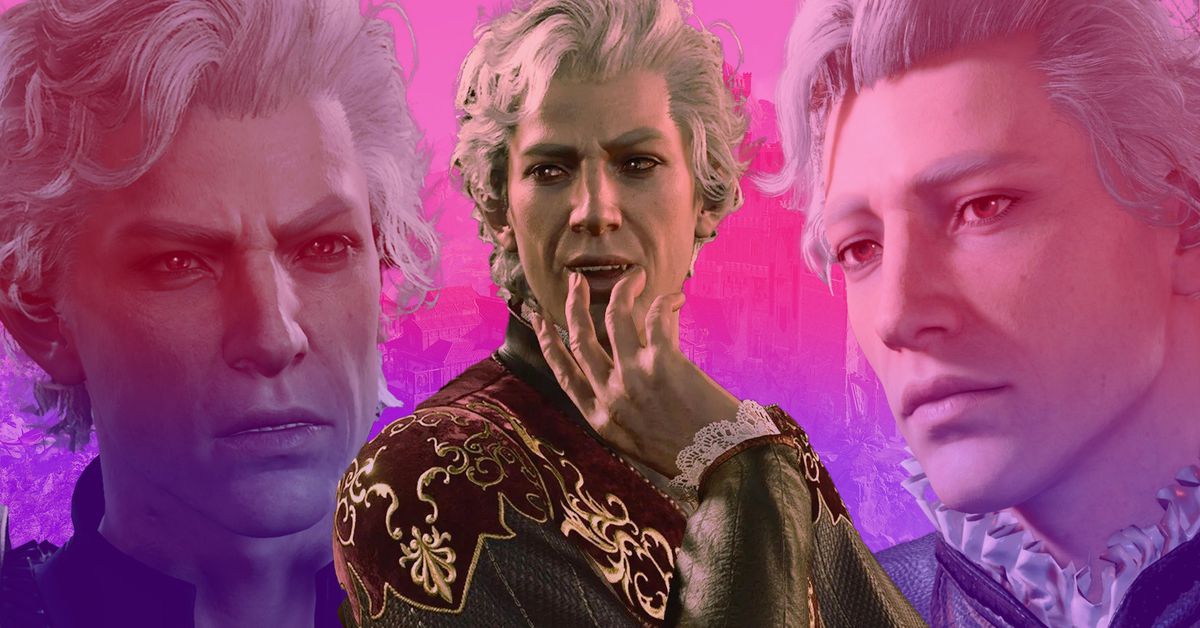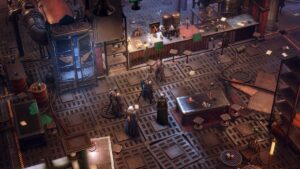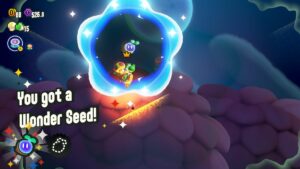
Months after Baldur’s Gate 3’s release, I continue to be haunted by one man. His face shows up on all of my feeds, he’s been the center of a few fan furors, and he feels like the natural evolution of some of my most beloved BioWare companions. I remain fascinated by Astarion, who has more than earned his place in the hall of fame of RPG allies, and I am not alone.
It’s interesting that Astarion is at the center of so much discourse, because he’s not the most popular romance option in the game. He’s not even in the top three, trailing behind Shadowheart, Lae’zel, and Karlach. But the conversations around him are a particular flavor of intense, as fans thirst over him, connect with his heartfelt story arc, and discuss the nuances of his personality. Even months after Baldur’s Gate 3 was released, new updates and mods that relate to Astarion inspire controversy. Fans pore over the dev notes, compare different variations of cutscenes, and occasionally turn on each other to fervently debate in defense of their favorite vampire beau.
Astarion has an immediately obvious appeal: He’s a sexy vampire. Pop culture is littered with variations on this archetype; everyone remembers a few years where Twilight’s Edward Cullen was plastered everywhere, and he’s predated by similarly sexy icons from literary canon. But beyond his immediate appeal, Astarion proved himself an entertaining companion. He’s hilarious, occasionally passive-aggressive, and deeply petty. As such, it’s no surprise that he still continues to inspire memes and jokes.
I’ve seen a surplus of silly memes giving Astarion a gun or bedecking him in clown makeup, and based on my own experience, he inspires these tributes at a higher rates than the other Baldur’s Gate 3 companions. This is in large part due to the performance of recent Game Award winner Neil Newbon, who does a phenomenal job portraying each facet of Astarion’s personality. A lesser performance might have tempted players to stake the thirsty vampire early on, but Newbon elevates even simple scenarios with a perfectly dramatic delivery.
[embedded content]
This does an enormous amount of heavy lifting with Astarion’s earlier appearances, but Newbon deftly handles the portrayal even as the game gets much more serious. The closer a player gets to Astarion, the more they uncover about his tragic past. Astarion is a vampire spawn, turned by Cazador Szarr. Cazador is a cruel sire, inflicting torture upon Astarion in order to inflict obedience. This is part of why Astarion is much less freaked out about the tadpole in his head than the rest of the party; the affliction grants him freedom to walk under the sun, free from the oppressive control of his master.
Astarion’s relationship with Cazador shapes his personality. He’s manipulative, willing to trade on his physical charms, and supremely self-interested. Ultimately, his story is one of the cycle of abuse. The player finds that Cazador was abused by his own master, and when he assumed power, he inflicted that same pain on Astarion. Everything culminates in a final choice for Astarion: He can Ascend, breaking the bonds of both Cazador and the tadpole and becoming a powerful vampire lord himself, or he can turn down the power, accept his weaknesses, and live as a vampire spawn in the darkness.
It’s a compelling story, and one that can be experienced in many ways. The player can be Astarion through an Origins run, and if they’re playing Tav or the Dark Urge, they can befriend, romance, or betray Astarion. It’s commonly accepted that Ascended Astarion is the “worse” ending for him, one that opens him up to continue the cycle of abuse. But that’s not a universally believed theory; some players, thanks to the decisions they make and bonds they form, think that they can trust Astarion with that power. Others are more skeptical.
That conflict is further complicated by the fact that Astarion himself works to manipulate the player. When I first learned about the Ascendancy ritual on my Tav run, I expressed my concerns to Astarion... who then gave me the biggest puppy-dog eyes and said it would thrill him to Ascend. “Don’t you want me to be happy?”
It is masterful writing on Larian’s part — it takes more than just romancing Astarion to redeem him. Instead, it takes genuine friendship, sincerity, and vulnerability by both parties. Despite all the saucy Rule 34 art fans have drawn of Astarion, the moment where I felt most connected to him was in Act 2, when we just held hands and made eye contact. If I had made other choices, things could have turned out very differently. Protagonist Tav can manipulate Astarion in return, and break the vampire’s heart in the process.
Astarion’s plot is full of nuanced, messy, painful writing, and that’s what’s inspired such a long-lasting, brightly-burning fandom for the character on social media. There are the silly, surface-level memes about giving Astarion a gun — but there’s also a ton of players who connected with his inner struggle and see themselves reflected in his scars. That depth of characterization is what has inspired such a fervent fandom, and I am sure I’ll see Astarion arguments on my feed for months, and likely years, to come.
- SEO Powered Content & PR Distribution. Get Amplified Today.
- PlatoData.Network Vertical Generative Ai. Empower Yourself. Access Here.
- PlatoAiStream. Web3 Intelligence. Knowledge Amplified. Access Here.
- PlatoESG. Carbon, CleanTech, Energy, Environment, Solar, Waste Management. Access Here.
- PlatoHealth. Biotech and Clinical Trials Intelligence. Access Here.
- Source: https://www.polygon.com/24044421/baldurs-gate-3-astarion-debates-ascend-memes
- :has
- :is
- :not
- :where
- $UP
- a
- About
- abuse
- abused
- Accept
- accepted
- Act
- After
- All
- alone
- also
- am
- amount
- an
- and
- appeal
- appearances
- Arc
- ARE
- arguments
- around
- Art
- AS
- ascend
- assumed
- At
- award
- based
- BE
- because
- becoming
- been
- behind
- believed
- beloved
- Beyond
- Biggest
- Bonds
- both
- both parties
- Break
- Breaking
- but
- by
- CAN
- Center
- character
- choice
- choices
- closer
- come
- commonly
- companion
- companions
- compare
- compelling
- compelling story
- complicated
- Concerns
- conflict
- Connect
- connected
- contact
- content
- continue
- continues
- control
- conversations
- could
- Culture
- cycle
- Dark
- debate
- decisions
- deeply
- Defense
- delivery
- depth
- Despite
- Dev
- differently
- discourse
- discuss
- does
- down
- dramatic
- drawn
- due
- each
- Earlier
- Early
- earned
- Edward
- elevates
- embedded
- ending
- enormous
- entertaining
- Even
- everyone
- everything
- everywhere
- evolution
- experience
- experienced
- expressed
- eye
- Eyes
- Face
- fact
- FAME
- fan
- fans
- Favorite
- feels
- felt
- few
- final
- finds
- First
- flavor
- For
- form
- Free
- Freedom
- Friendship
- from
- full
- further
- game
- gate
- gave
- genuine
- Giving
- good
- grants
- had
- Hall
- Handles
- Hands
- happy
- Have
- he
- head
- Heart
- heavy
- heavy lifting
- Held
- higher
- hilarious
- him
- himself
- his
- HTTPS
- i
- I’LL
- icons
- if
- immediate
- immediately
- in
- inflict
- inner
- inspire
- inspired
- inspires
- instead
- interesting
- IT
- Job
- jpg
- just
- large
- learned
- less
- lesser
- lifting
- like
- likely
- live
- made
- make
- makeup
- man
- many
- master
- me
- Media
- memes
- might
- moment
- months
- more
- most
- Most Popular
- much
- my
- Natural
- New
- no
- nuances
- obvious
- of
- on
- ONE
- opens
- Option
- or
- order
- origins
- Other
- Others
- out
- over
- own
- Pain
- painful
- part
- particular
- parties
- party
- past
- perfectly
- performance
- Personality
- phenomenal
- physical
- Place
- plato
- Plato Data Intelligence
- PlatoData
- player
- players
- playing
- Polygon
- pop
- Pop Culture
- Popular
- power
- powerful
- process
- protagonist
- proved
- Rates
- reason
- redeem
- reflected
- relationship
- release
- released
- remain
- REST
- romance
- RPG
- Rule
- Run
- Said
- same
- scenarios
- see
- seen
- self-interested
- serious
- shapes
- Shows
- Similarly
- Simple
- skeptical
- So
- Social
- social media
- some
- Spawn
- stake
- Still
- Story
- Struggle
- such
- Sun
- sure
- surplus
- surprise
- takes
- than
- thanks
- that
- The
- their
- themselves
- then
- theory
- There.
- These
- they
- things
- think
- thirsty
- this
- three
- thrill
- Through
- to
- Ton
- top
- torture
- trade
- Trust
- TURN
- Turned
- Ultimately
- uncover
- under
- universally
- Updates
- upon
- Vampire
- variations
- very
- vulnerability
- walk
- want
- was
- ways
- we
- What
- when
- WHO
- why
- willing
- winner
- with
- works
- would
- writing
- years
- you
- youtube
- zephyrnet









